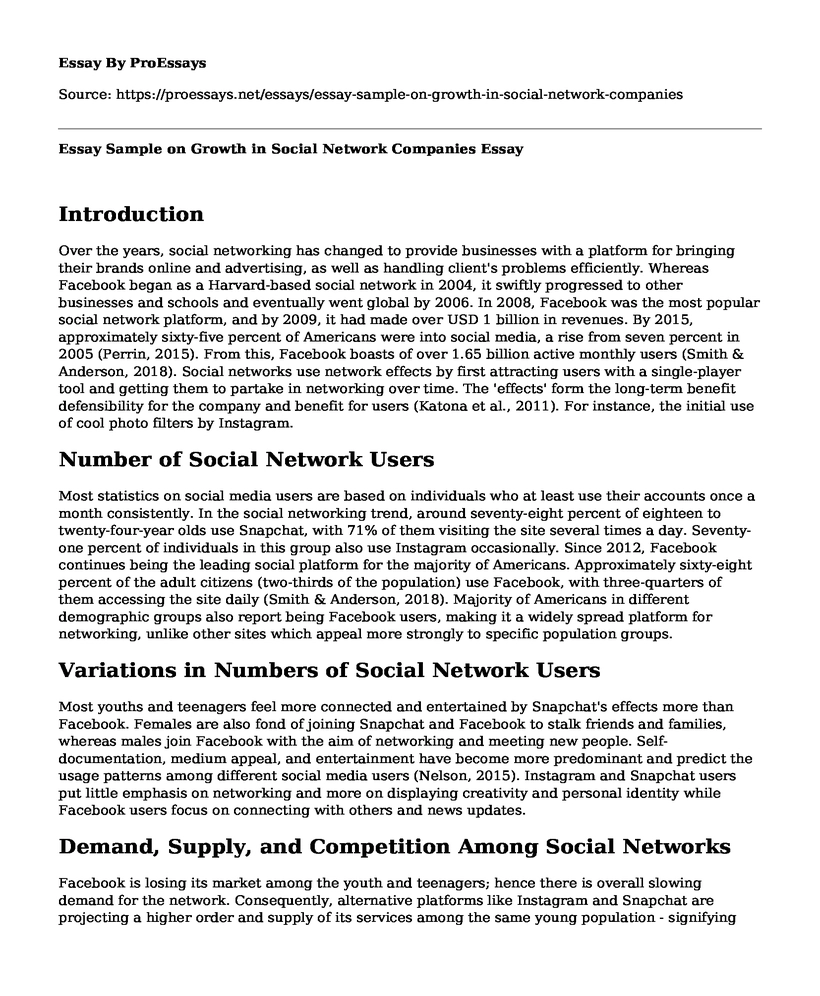Introduction
Over the years, social networking has changed to provide businesses with a platform for bringing their brands online and advertising, as well as handling client's problems efficiently. Whereas Facebook began as a Harvard-based social network in 2004, it swiftly progressed to other businesses and schools and eventually went global by 2006. In 2008, Facebook was the most popular social network platform, and by 2009, it had made over USD 1 billion in revenues. By 2015, approximately sixty-five percent of Americans were into social media, a rise from seven percent in 2005 (Perrin, 2015). From this, Facebook boasts of over 1.65 billion active monthly users (Smith & Anderson, 2018). Social networks use network effects by first attracting users with a single-player tool and getting them to partake in networking over time. The 'effects' form the long-term benefit defensibility for the company and benefit for users (Katona et al., 2011). For instance, the initial use of cool photo filters by Instagram.
Number of Social Network Users
Most statistics on social media users are based on individuals who at least use their accounts once a month consistently. In the social networking trend, around seventy-eight percent of eighteen to twenty-four-year olds use Snapchat, with 71% of them visiting the site several times a day. Seventy-one percent of individuals in this group also use Instagram occasionally. Since 2012, Facebook continues being the leading social platform for the majority of Americans. Approximately sixty-eight percent of the adult citizens (two-thirds of the population) use Facebook, with three-quarters of them accessing the site daily (Smith & Anderson, 2018). Majority of Americans in different demographic groups also report being Facebook users, making it a widely spread platform for networking, unlike other sites which appeal more strongly to specific population groups.
Variations in Numbers of Social Network Users
Most youths and teenagers feel more connected and entertained by Snapchat's effects more than Facebook. Females are also fond of joining Snapchat and Facebook to stalk friends and families, whereas males join Facebook with the aim of networking and meeting new people. Self-documentation, medium appeal, and entertainment have become more predominant and predict the usage patterns among different social media users (Nelson, 2015). Instagram and Snapchat users put little emphasis on networking and more on displaying creativity and personal identity while Facebook users focus on connecting with others and news updates.
Demand, Supply, and Competition Among Social Networks
Facebook is losing its market among the youth and teenagers; hence there is overall slowing demand for the network. Consequently, alternative platforms like Instagram and Snapchat are projecting a higher order and supply of its services among the same young population - signifying young users prefer more visual and newer social networks. Growth in the varying number of users among the platforms is vital. Instagram and Facebook and its Messenger units have aggressively gone after Snapchat by copying most of its favourite feature, putting Snapchat's user's growth rate at risk, and making it less competitive - hence advertisers have no motivation of placing adverts on the platform.
Future of Social Networks
Social networking will continue being more prominent in the future and governments will be able to engage citizens vastly and more efficiently. For instance, future political influence will be network-based since platforms such as Facebook help in accessing and evaluating political opinions. They could also use such platforms to directly reach out and inform citizens in case of a crisis in the nation. These opportunities will continue shaping and influencing how governments operate and how individuals socialize, work, and live in the universe.
References
Katona, Z., Zubcsek, P. P., & Sarvary, M. (2011). Network Effects and Personal Influences: The Diffusion of An Online Social Network. Journal of Marketing Research, 48(3), 425-443. Retrieved from https://www.jstor.org/stable/23033849
Nelson, D. W. (2015). Millennial Social Networking Behavior from a Uses and Gratifications Perspective (Order No. 3710560). Available from ABI/INFORM Global. (1703476939). Retrieved from. http://gsuproxy.govst.edu:2109/login?url=https://gsuproxy.govst.edu:4959/docview/1703476939?accountid=27966
Perrin, A. (2015). Social Media Usage: 2005-2015. Retrieved from http://www.pewinternet.org/2015/10/08/social-networking-usage-2005-2015/
Smith, A., & Anderson, M. (2018). Social Media Use In 2018: A Majority of Americans Use Facebook And YouTube, But Young Adults Are Especially Heavy Users of Snapchat And Instagram. Pew Research Centre. Retrieved from http://www.pewinternet.org/2018/03/01/social-media-use-in-2018/
Cite this page
Essay Sample on Growth in Social Network Companies. (2022, Dec 07). Retrieved from https://proessays.net/essays/essay-sample-on-growth-in-social-network-companies
If you are the original author of this essay and no longer wish to have it published on the ProEssays website, please click below to request its removal:
- Shelter Story Paper Example
- Gender and Family Structure Essay
- Essay Example on Apple's Success in China: Merits of Following Procedures
- Essay on Brown and Levinson's Framework: Advancing Human Speech & Communication
- Essay Sample on Cultural Adaptation: How Puerto Rican Society Evolves
- Essay Example on Explore NYC: America's Largest and Most Influential Metropolis
- Paper Example on 5 Steps to Effectively Use CR in Organizations







